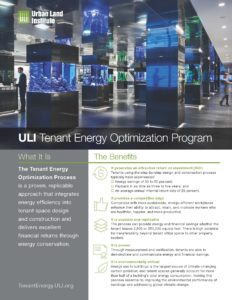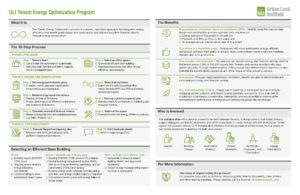Tenant Engagement
ULI’s Greenprint Center works broadly on tenant engagement, offering a returns-based approach to integrating energy efficiency into tenant space design and construction that leads to reduced energy use and costs. The foundation of ULI’s Tenant Energy Optimization program is a ten-step process that, when implemented in ten pilot fit-out projects, resulted in energy savings of 30 to 50 percent within a three- to five-year payback period—and an average 25 percent internal rate of return over the life of a ten- to 15-year lease. To support building owners, tenants, architects, engineers, and other service providers interested in implementing the process, the program provides tools such as technical resources guides, how-to documents, case studies, and other training materials as listed below:
Working toward Net Zero: Tenant Engagement Best Practices and Examples
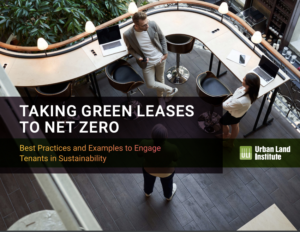 Base-building energy efficiency improvements are an important step for decarbonization, but the industry cannot achieve its ambitious carbon reduction goals without also addressing tenant spaces, which can account for well over 50 percent of total energy consumption in commercial buildings. Many tenant companies share the goal of reducing their carbon emissions and have taken action to do so, including setting their own net zero goals. To achieve whole-building reductions in carbon emissions, property owners and tenants must work together—sometimes in new and creative ways. The primers on this Knowledge Finder page provide support to owners in the tenant engagement step of the road map to net zero by highlighting the business case and providing examples of landlord-tenant collaboration to achieve net zero goals. The primers are organized around common challenges that owners and tenants face, as well as examples of owners and tenants overcoming these challenges together. Check out the first two primers, Taking Green Leases to Net Zero and Sharing Data to Achieve Net Zero
Base-building energy efficiency improvements are an important step for decarbonization, but the industry cannot achieve its ambitious carbon reduction goals without also addressing tenant spaces, which can account for well over 50 percent of total energy consumption in commercial buildings. Many tenant companies share the goal of reducing their carbon emissions and have taken action to do so, including setting their own net zero goals. To achieve whole-building reductions in carbon emissions, property owners and tenants must work together—sometimes in new and creative ways. The primers on this Knowledge Finder page provide support to owners in the tenant engagement step of the road map to net zero by highlighting the business case and providing examples of landlord-tenant collaboration to achieve net zero goals. The primers are organized around common challenges that owners and tenants face, as well as examples of owners and tenants overcoming these challenges together. Check out the first two primers, Taking Green Leases to Net Zero and Sharing Data to Achieve Net Zero
Green Leasing as Part of a Sustainable Tenant Fit-Out
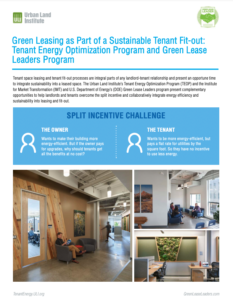
Building owners and tenants are often characterized by conflicting interests and split incentives, hindering joint efforts towards energy efficient buildings. However, both parties play a vital role in embedding sustainability into the built environment and ultimately have common ground that can be leveraged to achieve shared goals. The Urban Land Institute’s (ULI) Tenant Energy Optimization Program (TEOP) and the Institute for Market Transformation (IMT) and U.S. Department of Energy’s (DOE) Green Lease Leaders program share complementary, actionable steps for landlord-tenant collaboration in advancing sustainability in leased spaces. Green Leasing as Part of a Sustainable Tenant Fit-out: Tenant Energy Optimization Program and Green Lease Leaders Program provides an overview of TEOP and Green Lease Leaders, highlighting how the two programs can work together to offer a robust roadmap for landlord-tenant energy efficiency achievements. Check out Green Leasing as Part of a Sustainable Tenant Fit-Out.
ULI Tenant Energy Optimization Program
The Tenant Energy Optimization Program is a proven, replicable approach that integrates energy efficiency into tenant space design and construction and delivers excellent financial returns through energy conservation. The program has several benefits including, generating an attractive ROI, providing a competitive edge by creating a sustainable and energy-efficient workplace, and the program is scalable and replicable to different tenant spaces.
10-Step Tenant Energy Optimization Process
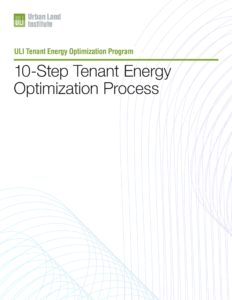 This 10-Step Tenant Energy Optimization Process details pre-lease, design and construction, and post-occupancy phases. The process emphasizes the importance of collaboration among tenants, building owners, and service providers. Tenants using the step-by-step design and construction process typically demonstrate energy savings of 30 to 50 percent, have payback periods of three to five years, and average a 25 percent internal rate of return (IRR). This process can be replicated by any tenant and used as reference for sustainable build-outs no matter where you fall on the building spectrum.
This 10-Step Tenant Energy Optimization Process details pre-lease, design and construction, and post-occupancy phases. The process emphasizes the importance of collaboration among tenants, building owners, and service providers. Tenants using the step-by-step design and construction process typically demonstrate energy savings of 30 to 50 percent, have payback periods of three to five years, and average a 25 percent internal rate of return (IRR). This process can be replicated by any tenant and used as reference for sustainable build-outs no matter where you fall on the building spectrum.
ULI Tenant Energy Optimization Program Infographic
The Tenant Energy Optimization Program Infographic provides stakeholders with an overview of ULI’s TEOP program as well as outline of the 10-step process which outlines steps you can take to integrate energy efficiency into tenant space, design, and construction.
Following the TEOP 10 Steps Helps an Office Fit-out Meet Energy Star Tenant Space Criteria
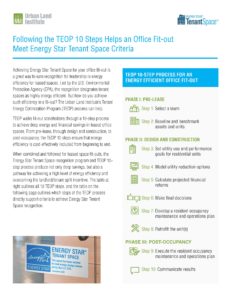 Following the TEOP 10 Steps Helps an Office Fit-out Meet Energy Star Tenant Space Criteria by walking fit-out stakeholders through a 10-step process
Following the TEOP 10 Steps Helps an Office Fit-out Meet Energy Star Tenant Space Criteria by walking fit-out stakeholders through a 10-step process
to achieve deep energy and financial savings in leased office spaces. Achieving Energy Star Tenant Space for your office fit-out is a great way to earn recognition for leadership in energy efficiency for leased spaces. Led by the U.S. Environmental Protection Agency (EPA), the recognition designates tenant spaces as highly energy efficient. But how do you achieve such efficiency in a fit-out? The Urban Land Institute’s Tenant Energy Optimization Program (TEOP) process can help. From pre-lease, through design and construction, to post-occupancy, the TEOP 10 steps ensure that energy efficiency is cost-effectively included from beginning to end.
10 Steps for Multifamily Owners, Operators, and Investors to Achieve Energy Optimization in Residential Unit
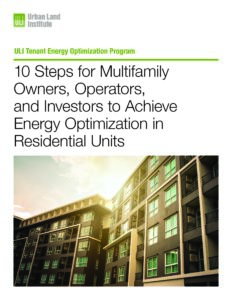 10 Steps for Multifamily Owners, Operators, and Investors to Achieve Energy Optimization in Residential Units provides owners, operators, and investors with a guide to actionable steps to move toward improved building energy efficiency and achieving some of these notable cost savings. With up to $3.4 billion in energy cost savings available to the multifamily market each year, energy efficiency and optimization are top of mind for owners, operators, and investors in multifamily real estate. Achieving these savings requires a multistep approach that can work for residential unit buildouts in existing multifamily buildings and can also be applied, in certain cases, to major renovation projects.
10 Steps for Multifamily Owners, Operators, and Investors to Achieve Energy Optimization in Residential Units provides owners, operators, and investors with a guide to actionable steps to move toward improved building energy efficiency and achieving some of these notable cost savings. With up to $3.4 billion in energy cost savings available to the multifamily market each year, energy efficiency and optimization are top of mind for owners, operators, and investors in multifamily real estate. Achieving these savings requires a multistep approach that can work for residential unit buildouts in existing multifamily buildings and can also be applied, in certain cases, to major renovation projects.
TEOP for Architects: How Architects Can Drive High-Performance Office Fit-out Projects
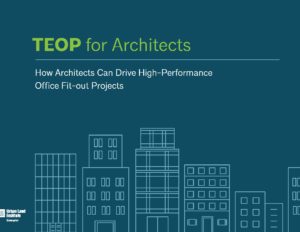 TEOP for Architects address the important role architects play in ensuring that the tenant fit-outs are designed as sustainable and energy efficient as possible. Industry research indicates that client demand continues to drive growth in high-performance, energy-efficient buildings and spaces. ULI’s Greenprint Center and the American Institute of Architects (AIA) have partnered to publish this resource, which gives architects a road map to the TEOP process that better situates them to help their clients create energy-efficient leased spaces.
TEOP for Architects address the important role architects play in ensuring that the tenant fit-outs are designed as sustainable and energy efficient as possible. Industry research indicates that client demand continues to drive growth in high-performance, energy-efficient buildings and spaces. ULI’s Greenprint Center and the American Institute of Architects (AIA) have partnered to publish this resource, which gives architects a road map to the TEOP process that better situates them to help their clients create energy-efficient leased spaces.
Greenprint
